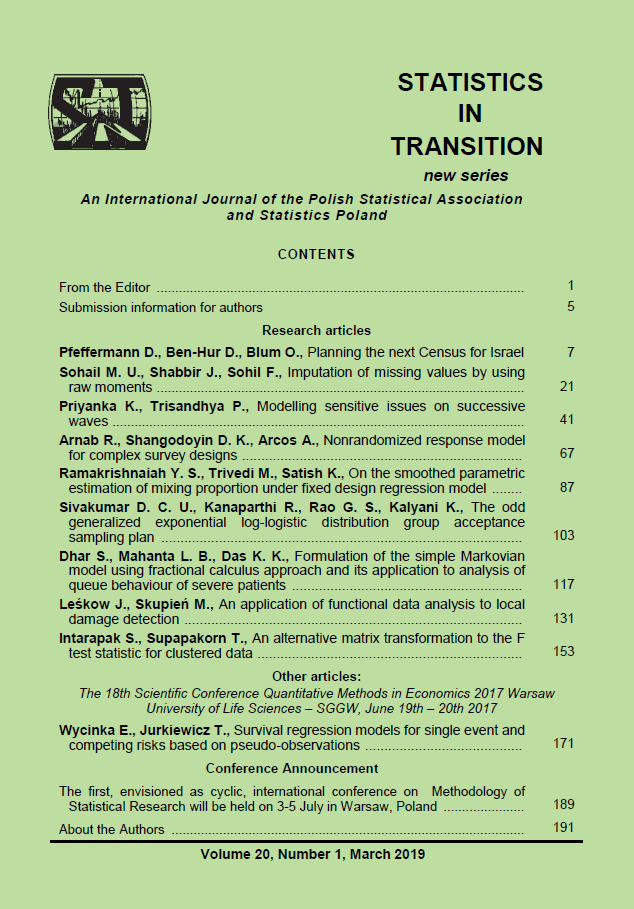ARTICLE
ABSTRACT
The present paper revisits an estimator proposed by Boes (1966) – James (1978), herein called BJ estimator, which was constructed for estimating mixing proportion in a mixed model based on independent and identically distributed (i.i.d.) random samples, and also proposes a completely new (smoothed) estimator for mixing proportion based on independent and not identically distributed (non-i.i.d.) random samples. The proposed estimator is nonparametric in true sense based on known “kernel function” as described in the introduction. We investigated the following results of the smoothed estimator under the non-i.i.d. set-up such as (a) its small sample behaviour is compared with the unsmoothed version (BJ estimator) based on their mean square errors by using Monte-Carlo simulation, and established the percentage gain in precision of smoothed estimator over its unsmoothed version measured in terms of their mean square error, (b) its large sample properties such as almost surely (a.s.) convergence and asymptotic normality of these estimators are established in the present work. These results are completely new in the literature not only under the case of i.i.d., but also generalises to non-i.i.d. set-up.
KEYWORDS
mixture of distributions, mixing proportion, smoothed parametric estimation, fixed design regression model, mean square error, optimal band width, strong consistency, asymptotic normality
REFERENCES
ACHESON, M. A., McELWEE, E. M., (1951). Concerning the reliability of electron tubes, Proceedings of the IRE, Vol. 40, pp. 1204–1206.
BERNSTEIN, S. N., (1946). The Theory of Probabilities, Gastehizdat Publishing House, Moscow.
BOES, D. C., (1966). On the estimation of mixing distributions, Ann. Math. Statist. 37, pp. 177–188.
BLISCHKE, W. R., (1965). Mixtures of discrete distributions, Collected papers presented at the Int. Simp. Ed. By G. P. Patil, Oxford, Pergamon.
BRUNI, C. et al., (1985). On the inverse problem in cytofluorometry-recovering DNA distribution from FMF date, Cell Bio. Physics 5, pp. 5–19.
CHOI, K., BULGREN, W. G., (1968). An estimation procedures for mixtures distributions, J.R.S.S. Series B (Methodological), Vol. 30, No. 3, pp. 444–460.
CLARK, M. V., (1976). Some methods for statistical analysis of multi-model distributions and their application to grain-size data, J. Math. Geol. 8, pp. 267–282.
CHRISTENSEN, P. R. et al., (1980). Gamma-ray multiplicity moments from 86 kr reactions on 144, 154 at 490, Mev. Nuclear Phys. A 349, pp. 217–257.
DAVIS, D. J., (1952). An analysis of some failure date, Jour. Amer.Stat.Assoc., 47, pp. 113–150.
EPSTEIN, B., (1953). Statistical problems in life testing, proceeding of The Seventh Annual Convention, American Society of Quality Control.
EVERITT, B., HAND, D., (1981). Finite mixture distributions. Chapman and Hall, London.
FU, K. S., (1968). Sequential methods in pattern recognition and machine learning, Academic Press, New York.
HARRIS, E. K., (1958). On the probability of survival of bacteria in sea water, Biometrics, 14, pp. 195–206.
HERD, G. R., (1953). Heterogeneous distributions. Unpublished technical note.
HOSMER W. DAVID, (1973). A comparison of iterative maximum likelihood estimates of the parameters of a mixture of two normal distributions under three different types of sample. Biometrics, 29, pp. 761–770.
JAMES, I. R., (1978). Estimation of the Proportion in a mixture of two normal distributions from simple, rapid measurements, Biometrics, pp. 265–275.
JAYALAKSHMI, C., SUDHAKAR RAO, M., (2002). Estimation of mixing proportion using smooth distribution function in two population mixture model, Aligarh Jl. of Statistics, Vol. 22, pp. 91–99.
JEWEL, N. P., (1982). Mixture of Exponential distributions, Annals of Statistics, Vol. 10, No. 2, pp. 479–484.
KARL PEARSON, (1894). Contributions to the mathematical theory of evolution, Phil. Trans. Roy Soc. 185 A, pp. 71–110.
LINDSAY, B. G., (1995). Mixture models: Theory geometry and applications. NSF-CBMS Regional Conference Series in Probability and Statistics, Vol. 5, Institute of Mathematical Statistics, Hayward.
MENDENHALL, W., HADER, R. J., (1958). Estimation of parameters of mixed exponentially distributed failure time distributions from censored life test data, Biometrika 45(3-4), pp. 504–520. MACDONALD, P. D. M., PITCHER, T. J., (1979). Age groups from size frequency data, J. Fish. Res. Bd. Cano. 36, pp. 987–1008.
McLACHLAN, G. J., BASFORD, K. E., (1988). Mixture Models: Inference and Applications to Clustering. New York: Marcel Dekker.
McLACHLAN, G. J., PEEL, D., (2000). Finite mixture models, Wiley, New York.
MERZ, P. H., (1980). Determination of absorption energy distribution by regularization and a characterization of certain absorption isotherms, J. Comput. Phys. 34, pp. 64–85.
STEEN, J. R., (1952). Life testing of electronic tubes, Unpublished paper presented at a summer statistics conference, University of North Carolina.
TITTERINGTON, D. M. et al., (1985). Statistical analysis of finite mixture distributions. John Wiley & Sons.
WILDE, R. D., (1952). Nature of rate of failure curves, Unpublished paper presented at a summer statistics conference, University of North Carolina.
ODELL, P. L., BASU, J. P., (1976). Concerning several methods for estimations crop acreages using remote sensing data, Commun. Statist. A 5, pp. 1091–1114.
VAN HOUWELINGEN, J. C., DEVRIES, (1974). Minimax estimation of mixing proportion of two known distributions, J. American Stat. Asso., 397, pp. 300–304.
VARLI, Y. et al., (1975). A statistical model for position emission tomography, JASA, 80, pp. 8–20.
